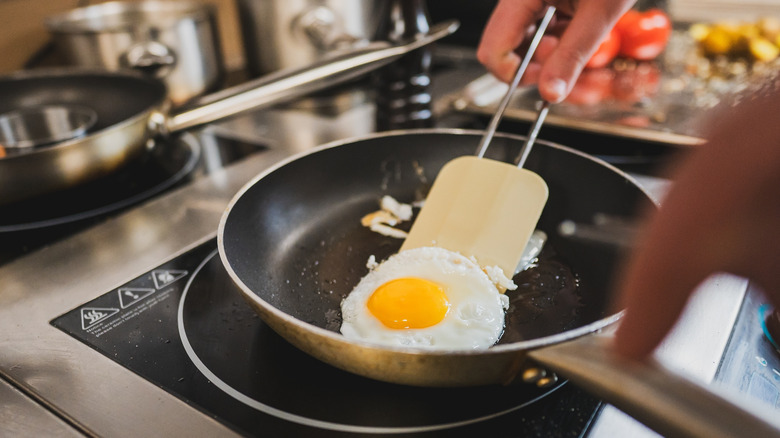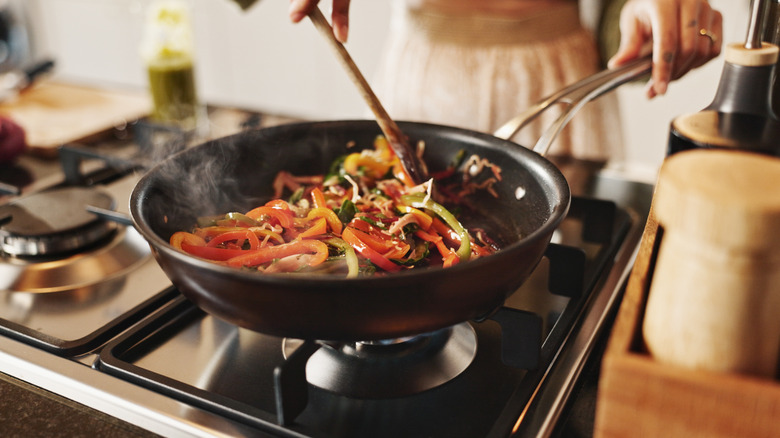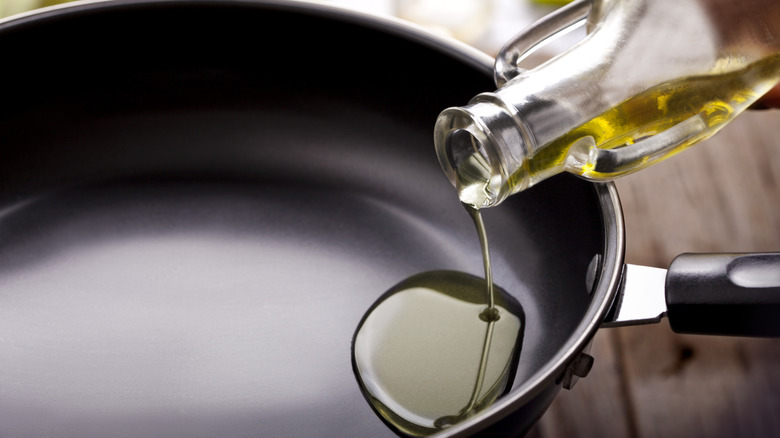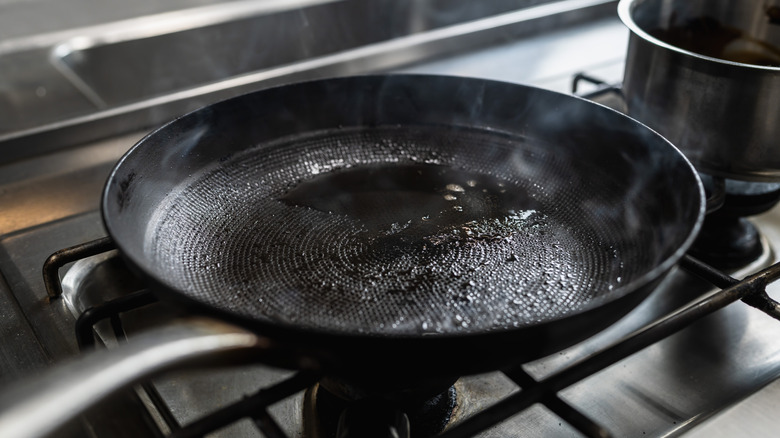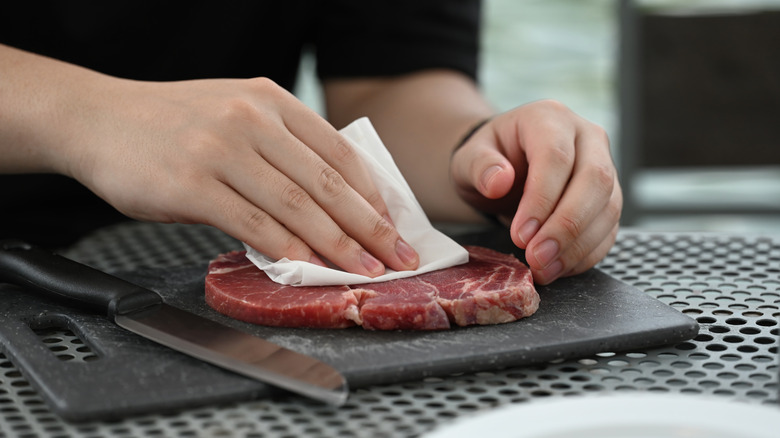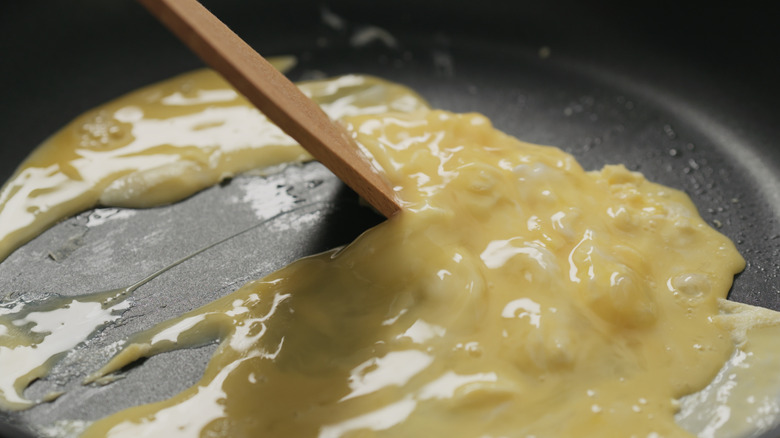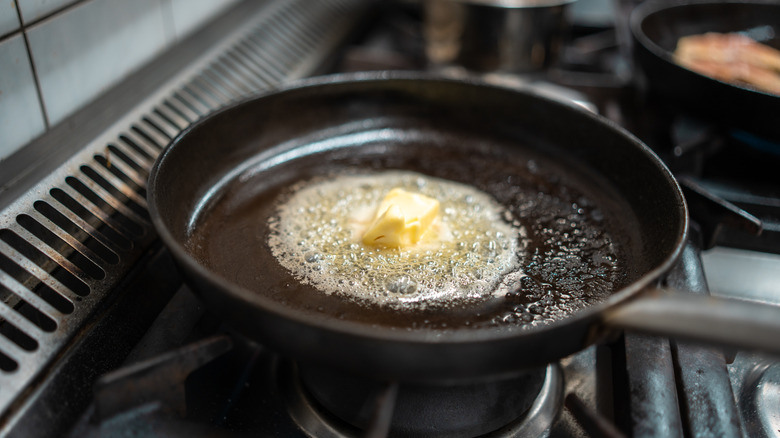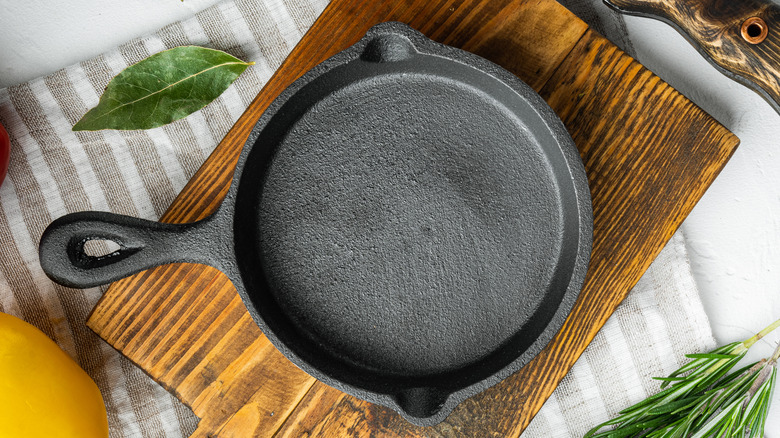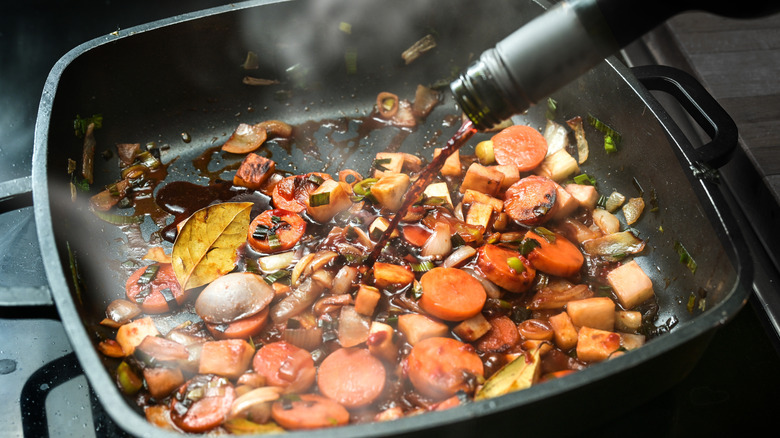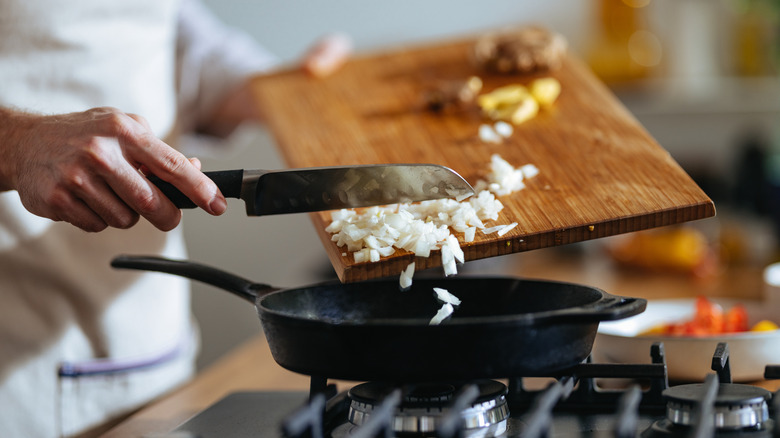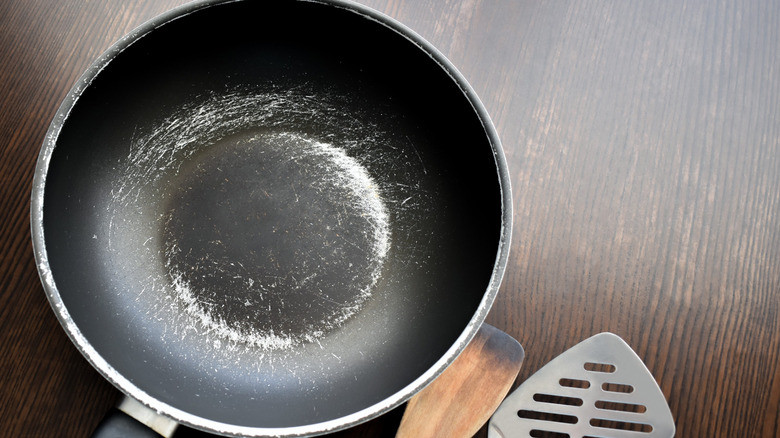11 Reasons Your Food May Be Sticking To Your Pans
We may receive a commission on purchases made from links.
You've measured, chopped, and seasoned all the ingredients, you almost know the recipe by heart, yet you can't help but feel afraid that your food will stick once it hits the pan. In all fairness, ending up in an exhausting scraping competition is grounds to feel uneasy, and can quickly turn you off from the recipe or cooking in general. You can always try to clean burnt pans with sugar cubes, but we're not subject to the whims of our cookware. In fact, there are plenty of steps you can take to ensure your recipes will cook evenly and flip without sticking.
It's true that in some cases, the goal of the dish is to get a layer of food that almost sticks to the pan. The crust of tahdig or the socarrat in Spanish paella, for example, both feature flavorful scorched rice as their star ingredient. For most preparations, though, you want to achieve the Maillard reaction that gets your food crispy but keeps it in motion around the pan. Foods like meat, eggs, and cheese prove the most frustrating when it comes to sticking, thanks to their proteins that naturally like to bond with the pan's surface when exposed to heat.
To prevent future devastation, preventing sticking comes down to sensory cues, nuances between non-stick, cast iron, or stainless steel pans, and practice. We've compiled some of the top reasons food may be sticking to your pans below, including best-practice techniques and some mistakes to avoid.
Using the wrong type of pan
One of the most pressing considerations before starting any recipe is how well your pan can prevent sticking. If you've ever bravely attempted scrambled eggs with stainless steel, you'll understand the wrong pan can make something simple quickly devolve into a frantic cycle of scraping and frustration. That's because your pan directly determines how challenging (and how much cleanup) the dish will entail.
Plenty of home cooks, however, hesitate before reaching for their non-stick pan. Coated with Teflon, the surface is effortlessly stick-proof, but this synthetic material can scratch off or release harmful fumes. According to Healthline, Teflon products have been free of PFOA — a material that poses serious health risks — since 2013. These products could still contain other lesser-understood compounds called PFAS, but if you're correctly using a quality non-stick pan (like this one from Tramontina on Amazon), it shouldn't cause any concern.
In fact, non-stick pans are a lifesaver for delicate foods cooked at low to medium heat, including pancakes, flaky fish, or cheesy crusts. As simple as they make our lives though, you shouldn't use non-stick pans to make smash burgers, or really anything that needs a solid sear or deep fry. That's where cast iron pans with thicker bottoms and a higher temperature endurance can work their magic. Stainless steel pans, although notoriously finicky, give you quicker temperature control and can handle acidity better than other pans. They're great for sauces, stir-fries, and veggies.
You're not adding enough fat
Even if it's shiny enough to check your reflection, the surface of your pan is anything but smooth. At a microscopic level, the surface is actually a maze of ridges and canyons, not to mention the occasional nick or dent. The surface of your food will sink directly into these craters if there's no buffer zone, leading to some sticky situations. Non-stick pans compensate by filling and smoothing out the pan's jagged surface with Teflon. With cast iron or stainless steel, though, you need to create the even surface that keeps your food from sticking.
Using fat — like butter, oil, or animal fat — is the best way to add a layer between the food and the pan. None of us are strangers to using fat in cooking, but it's equally important to make sure you're using enough. If you haven't drizzled an ample amount, the heat in the center of the pan will actively push oil away and to the edges, exposing the middle. To deter any immediate sticking, coat the pan thoroughly before cooking. That way, it's the hot oil — not the pan — that begins cooking your food first, creating a protective crust that won't stick to the metal pan.
Exactly how much oil to use depends on your dish. Chicken thighs, for example, release more of their own fats to prevent sticking, whereas a skinless chicken breast needs more help. If the pan starts looking dry, just add a little more oil.
You skipped preheating the pan to the ideal temperature
Just like an oven, pans need to be preheated before cooking. If your food hits the surface before it's at the right temperature, it will significantly slow down the heating process, making browning pretty much impossible and increasing the chances of sticking. A pan needs time to warm up slowly, allowing the heat to spread evenly. Cranking the stovetop to high may save you some time, but it could cause temperature gradients across the pan that make patches of your meal stick.
The temperature in your pan also has to be just right. In fact, messing up the ideal temperature is one of the biggest reasons your food keeps sticking. For starters, you rarely ever need to get your pan ripping hot. Intense heat can break down your fat, diminishing its ability to act as a barrier and risking burnt or smoking oil. Non-stick pans in particular should never be heated past medium-high, to avoid degrading their coating.
Getting your pan to the right temp is as easy as setting it on medium-high and practicing some patience. Shimmering oil is one indicator the pan is ready, but the Leidenfrost effect is another easy way to tell your stainless steel pan is preheated. Sprinkle a teaspoon of water into a clean pan during preheating. Instead of sizzling and evaporating, the droplets will bead together and glide around the pan when it's ready to go.
You're not prepping the food
Even when your pan is in tip-top shape, sticking is inevitable if you're not correctly preparing your food. First off, leave things out on the counter before cooking, allowing them to reach room temperature. Cracking eggs straight from the fridge into a hot pan, for example, will instantly plummet the surface temp and constrict the pan into a death grip on your omelet. Room temperature ingredients also guarantee a more uniform cooking process, especially if you're adding several distinct components to the pan.
The best defense against sticking, though, is removing any excess moisture from the food's surface. Pat down those rinsed veggies and dry off the thawed steak dripping with juices. Too much water on the food's exterior causes the hot pan to expend its energy into steaming rather than sizzling. As all that water evaporates, your food is cooking, but it isn't developing a nice brown sear that can resist sticking if it comes into direct contact with the pan's surface.
Keep in mind that it's impossible to completely eliminate all moisture from your food. Even a steak with a perfectly charred crust will still release some juices. However, a slightly damp surface can actually work in your favor. Remember the Leidenfrost effect? A small amount of moisture on the outside of your food will evaporate into little pockets of steam that act as an additional barrier against the pan, helping things to slip and slide instead of sticking.
Interfering with the cooking process
Although most of us use sensory cues to tell when our pan is hot enough –– rather than monitoring the precise temperature –– most cooking starts at around 350 degrees Fahrenheit. As the pan expands during preheating, its microscopic channels actually shrink. The temperature shock from adding food, however, causes these channels to reopen. Even with a proper coating of oil, this sudden reopening typically makes high-protein foods like eggs, meat, and cheeses stick at first.
Deciding how many times to flip steak on the grill is one thing, but the key with a pan is to avoid flipping food too early. As the pan's temperature bounces back, it closes its channels and loosens its grip, while your food undergoes the Maillard reaction. This caramelization develops a crust that is easy to flip and tastes delicious to boot. Gently prod the edges of the food during cooking. If you feel any resistance, wait for the crust to finish forming before flipping.
Of course, deciding when to intervene depends a lot on the dish. Tomato sauces and sautés benefit from constant stirring to prevent sticking, while pan-fried zucchini might require only one flip after forming a crust but before burning. It can help to keep an eye on your dish as it cooks, listening for a constant sizzle and watching the amount of oil. If it looks like things are moving too fast — or not fast enough — don't be afraid to adjust the temperature.
Using the wrong cooking utensils
Maybe the only reason you choose one spatula over another is because one is clean and the other is in a sink full of dirty dishes. We feel you, but that's not the best move to respect the integrity of your pan. Non-stick pans are susceptible to scraping, requiring a little more forethought before grabbing a cooking utensil.
Metal spatulas or cutlery can cause unnecessary wear and tear if you're not gentle, even on ceramic non-stick pans. A banged-up pan not only looks unsightly, but unwanted specks of coating could end up in your meals. Plus, surface scratches increase the chance of food sinking into and sticking to these defects, defeating the purpose of a non-stick. Wooden or silicone spatulas like this one from GIR on Amazon offer an overall safer cooking experience.
It's true that stainless steel pans are more resilient, but they'll suffer from excessive scratching if you're not careful with abrasive tools. Cast iron pans, however, are built to last and can withstand the use of metal utensils. Even an accidental scratch probably only impacted the seasoning, meaning at worst you might need to re-season the pan. That said, metal spatulas work best when cooking foods more prone to sticking, like flipping steaks, breaking apart ground beef, or scraping up browned bits to deglaze. Since silicone and wooden spatulas are more heat-resistant, choose these for constant stirring, taste testing, or if you're one to leave the utensil hanging out in the pan.
Choosing the wrong type of fat
As much as you'd like to use your artisanal extra virgin olive oil in the recipe, it's probably not doing you any favors coating the pan. Not all oils are created equally, and those that have undergone more processing can handle higher temperatures. Unrefined fats, like extra virgin olive oil, have lower smoke points and begin to degrade as the heat of the pan intensifies. This means your oil loses the very qualities that make it an effective lubricant. Plus, burnt oil can lend a bitter aftertaste to your meal. You could keep the pan's temp low enough to avoid smoking oil, but then you might never reach the right heat to caramelize your food.
Refined neutral oils like sunflower, avocado, and grapeseed are your best friend when you're cooking at medium-high to high heat. Their elevated smoking point allows them to do their job at preventing your food from sticking at much higher temperatures. Rendered animal fats like beef tallow or lard are most effective around medium heat.
Although butter will burn at higher temperatures, it's actually better than oil when you're cooking on low. Because oil and water are natural enemies, foods with high water concentrations (like eggs) will repel that coating of oil on your pan, increasing the risk of sticking. Butter is rich in fats, water, and other proteins, attracting components in both the food and the pan and maintaining a better stick-free barrier.
You forgot to season the cast iron pan
Cast iron pans are the type of cookware we treasure like family heirlooms. It does take a little effort on your part, though, to make the most of these pans and their non-stick potential. Just like stainless steel, cast irons have a rugged exterior that increases their surface area but can cause your food to stick if you don't season the pan. Unique to cast iron pans, seasoning is a process that develops over time thanks to polymerization — heated oil molecules bonding to the pan's rough surface. This prevents rusting, and perhaps more importantly, creates a permanent non-stick barrier.
Although some cast iron pans come with a factory pre-seasoning (like this one from Lodge on Amazon), many home cooks prefer to kickstart it themselves, rubbing their new pan with a thin coat of oil and baking it in the oven for about an hour. After this, the best way to season a cast iron pan is by using it regularly. Frequent use gradually bakes more layers of oil into the seasoning, becoming darker, glossier, and increasing its non-stick superpowers. The seasoning will even impart deeper, more complex flavors to your meals and can resist gentle scrubbing when washing.
It can help to boost the seasoning if you use a healthy glug of high smoke point oils when you cook, and avoid setting the pan to the highest temperature. Cast iron distributes and retains heat exceptionally well, meaning you can cook your food evenly without extreme temperatures.
There's not enough liquid
Even after following every step to keep your food from sticking, there are still a couple tricks to use if you get some stickage. For one, with dishes like a sauté of onion and garlic, feel free to add a splash of liquid if you've got some bits stubbornly clinging to the pan. The water will evaporate quickly, but should leave you enough time to scrape everything up. (Just make sure you're not flicking water into smoking hot oil.) When you're cooking down a sauce or gravy, it's equally important to ensure you've added enough liquid and haven't left any dry spots where your preparations can stick.
Sometimes we even want bits of food to brown and stick to the bottom of the pan, so we can later deglaze it for a rich finishing drizzle. Add a good pour of broth or wine to the pan and get to work incorporating all the caramelized bits into the liquid. Don't be afraid to add more if things start looking dry. Water and alcohol will evaporate quickly while the sauce continues to concentrate and soak up more flavor.
Although it veers into the nontraditional, you can even use liquid instead of oil to prevent sticking. When you're cooking ingredients like veggies, use the moisture that the food naturally releases plus a couple tablespoons of broth. This can establish a little lubricant and additional flavor when you're limiting the amount of oil you consume.
You're not following the correct order
In most cases, following a few simple steps can help prevent your food from sticking. First, preheat the pan, then add the oil, and when the oil is runny and shimmering, incorporate the food. Messing up this order impedes proper browning, failing to form the crust that's necessary to keep everything stick-free. For example, adding food before oil — or before it's hot enough — can cause the dish to simply absorb the oil, rather than sizzling in it. This is especially true for oil-hungry vegetables like eggplants.
Some of these steps can be tweaked depending on the cookware. Since a non-stick pan shouldn't be heated past medium-hot, you can actually preheat the pan and fat together. The oil will add a barrier that protects the cookware from releasing any toxins. When you're pushing higher temperatures on a cast iron or stainless steel, though, add oil once the pan is hot. The surface of the pan can get hotter than the smoke point of most oils, meaning if you heat them together the oil could start burning before the pan is even ready. Adding fat just before food lends you more control over the temperature of the oil, rather than letting it get smoking hot and out of hand.
In certain recipes, even the order in which you add specific ingredients can help avoid sticking. For fried rice, scramble the eggs first, before the rice soaks up the layer of oil. Or, sauté onions and garlic before adding ingredients like mushrooms, which can similarly drink up all the oil.
Your pan is in rough shape
The pan you use affects the flavor of your dish, from the fullness of cast iron to the straightforward finish of stainless steel or non-stick. Different pans also have different needs if you want to get the most out of your cooking and keep food from sticking. Whether it's the communal pan between roommates or the daily means for scrambling eggs, non-stick pans are probably the cookware that require the most care and have the shortest shelf-life. If the scratches across its surface are starting to resemble the road map of a chaotic city, it's time to throw out the non-stick pan. Not only are these scratches unhygienic and vectors for bacteria growth, they're damaging the coating that prevents sticking. Dark discoloration and rust are other signs the pan is ready for retirement.
Sometimes we're also guilty of setting the heat too high with our non-stick pan, or reusing it several times before washing. These burnt patches and built-up residue get in between your food and the non-stick surface. Plus, when you finally have to scrub these spots away, you'll risk further degrading the coating.
Stainless steel and cast iron pans are more durable — capable of being passed down through generations — but they're not without some occasional maintenance needs. To prevent rust and protect their surface, wash these pans shortly after cooking and leave a thin layer of oil on their surface during storage or between uses.
